

23th September 2025 (13 Topics)
Mains Issues
Context:
NHRC issued notices to the Delhi government after the death of a worker and injuries to three others during sewer cleaning.
Definition
- Manual scavenging refers to the physical cleaning, carrying, or handling of human excreta from insanitary toilets, open drains, pits, railway tracks, and sewer systems.
- It is considered a hazardous occupation due to direct exposure to pathogens, toxic gases, and physical risks.
|
Current Status in India
|
Violation of Fundamental Rights
- Article 17: Prohibits untouchability; manual scavenging perpetuates caste-based discrimination.
- Article 21: Right to life and dignity; exposure to human waste, toxic gases, and unsafe conditions violates this right.
- Social and Gender Dimension: Women face double discrimination – gender inequality plus caste-based stigma.
Legal Framework
- Prohibition of Employment as Manual Scavengers and Their Rehabilitation Act, 2013
- Prohibits employment as manual scavengers and construction of insanitary latrines.
- Mandates demolition or conversion of insanitary latrines into sanitary ones.
- Provides rehabilitation, including skill development, alternative employment, and financial support.
- SC/ST (Prevention of Atrocities) Act, 1989
- Criminalisesemployment of SCs in manual scavenging, protecting them from caste-based exploitation.
- Occupational Safety and Health(OSH)Code 2020
- Recognizes hazardous occupations and mandates safety standards, PPE, and employer accountability.
Major Challenges Faced
|
Category |
Issues |
|
Health |
High exposure to pathogens ? diseases like Hepatitis, Tetanus, Cholera; toxic gases (H2S) ? asphyxiation & sudden death |
|
Social Stigma |
Untouchability, caste-based discrimination, social exclusion |
|
Economic |
Low wages, contractual employment, no job security, perpetuating poverty |
|
Gender |
Women face sexual harassment, exploitation, and societal discrimination |
|
Psychological |
Anxiety, depression due to social stigma and unsafe work conditions |
|
Drug Use |
Coping mechanism for stress and stigma, exacerbating health risks |
Supreme Court Guidelines (Dr. Balram Singh Case, 2023)
- Eradication of manual sewer cleaning through mechanization and phased elimination.
- Rehabilitation & Compensation: Rs 30 lakh for death; Rs 10–20 lakh for disabilities; employment and education support for dependents.
- Accountability: State and contractors liable; penalties for outsourcing unsafe work.
- NALSA: Responsible for compensation management.
- Monitoring & Transparency: Portal for tracking deaths, compensation, and rehabilitation efforts.
Government Initiatives
- Safaimitra Suraksha Challenge: Awards for ULBs reducing manual scavenging deaths.
- Swachhta Abhiyan App: Reporting and monitoring tool for sanitation issues.
- Rashtriya Garima Abhiyan: Focused on rehabilitation and social dignity.
- National Commission for SafaiKaramchari: Monitoring and policy recommendations.
- SwachhtaUdyami Yojana (SUY) & NAMASTE: Promote mechanized sanitation ecosystems.
- ERSUs (Emergency Response Sanitation Units): Well-trained professional workforce.
Technological Initiatives
- Bandicoot Robot: Autonomous sewer cleaning.
- Endobot&Swasth AI: Pipeline diagnostics, contamination detection.
- Robo-Drain System: Automated underground sewer cleaning.
- Vacuum Trucks: Powerful pumps remove sewage without human entry.
Way Forward
- Mechanization: Robotic arms, vacuum trucks, and semi-automated systems to reduce human exposure.
- OHS Standards: Implement OSH Code 2020 for sanitation workers.
- Health Screenings: Regular checks for respiratory, dermatological, and infectious diseases.
- Capacity Building: Training, safety gear, and financial assistance for technological adoption.
- Gender Inclusion: Empower women through SHGs and equitable employment in sanitation services.
- Integration with Swachh Bharat Mission: Focus on worker safety, dignity, and skill development.


Mains Issues
Context:
The Union Cabinet approved the Clean Plant Programme (CPP) to provide Indian farmers with virus-free, high-quality planting material, aiming to enhance horticulture productivity and global competitiveness.
Ensuring Disease-Free Horticulture
Challenges in Plant Health
- Climate and Biotic Threats:
- Climate change, pests, and systemic pathogens like viruses pose major risks to crop productivity and quality.
- By the time symptoms appear in the field, yield losses are often irreversible.
- Significance of Preventive Measures:
- Use of high-quality seeds and disease-free planting material is recognized as the most effective strategy.
- Preventive measures have no adverse side effects compared to chemical interventions.
Overview of Clean Plant Programme (CPP)
- Launch and Implementation:
- Approved by Union Cabinet in August 2024, under the Ministry of Agriculture and Farmers Welfare.
- Implemented by the National Horticulture Board (NHB) with technical guidance from ICAR.
- Investment: ?1,765.67 crore, including $98 million ADB loan.
- Objectives:
- Provide virus-free planting material of key horticultural crops.
- Enhance farmer income, productivity, and global competitiveness.
- Promote equity, inclusivity, and climate-resilient practices.
- International Collaboration:
- Partnerships with Israel and the Netherlands for best practices and technology transfer.
Key Infrastructure and On-Ground Actions
- Clean Plant Centres:
- Nine centres to be established across India; three in Maharashtra for grapes, oranges, and pomegranates (?300 crore).
- National-level laboratory in Pune for original plant species research.
- Nursery Development:
- Large nurseries supported with ?3 crore; medium nurseries ?1.5 crore.
- Annual distribution: 8 crore disease-free seedlings.
- Hazard Analysis and Laboratory Assessments:
- Profiling viruses to ensure certification.
- Crop-specific surveys: Grapevine (578 samples), Apple (535 samples), Citrus in preparation.
- Bioinformatics pipeline for HTS data developed for faster virus detection.
- Source to Soil Protocol:
- Pathogen-free material undergoes re-testing, propagation, and distribution via accredited nurseries.
- Positive material undergoes virus elimination through tissue culture, heat, or cryo-therapy.
Benefits and Broader Impact
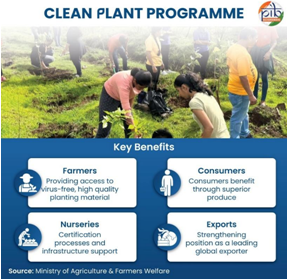
- Farmers:Higher yields, improved quality, and increased income.
- Nurseries:Streamlined certification, infrastructure support, and growth opportunities.
- Consumers:Virus-free, nutritious, and better-quality fruits.
- Exports:Strengthens India’s global horticultural competitiveness.
- Equity and Inclusivity:Affordable access for all farmers; active participation of women; region-specific clean plant varieties.
- Alignment with National Initiatives:
- Mission LiFE: Promotes sustainable and eco-friendly horticultural practices.
- National One Health Mission: Integrates human, animal, and environmental health to address plant-livestock-human interactions.
- MIDH: CPP complements Mission for Integrated Development of Horticulture, enhancing productivity from 12.10 MT/ha (2019–20) to 12.56 MT/ha (2024–25).
Comprehensive Analysis
- Strategic Importance: CPP addresses systemic pathogen threats, ensuring sustainable horticulture growth.
- Economic Impact: Boosts farmer income, rural employment, and export potential while reducing crop losses.
- Technological Integration: Hazard analysis, bioinformatics, and tissue culture enhance disease detection and prevention.
- Policy Synergy: Alignment with MIDH, Mission LiFE, and One Health ensures holistic development and sustainability.


Prelims Articles
Context:
The Tripura Sundari Temple in Udaipur, Tripura, is being redeveloped under the PRASHAD scheme, reflecting India’s vision of heritage-led spiritual tourism in the North-East.
Temple Significance:
- Tripura Sundari Temple, established in 1501 A.D., is a Shakti Peetha and a symbol of Tripura’s cultural, spiritual, and architectural heritage, attracting devotees nationally and internationally.
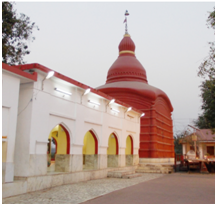
PRASHAD Scheme:
- Pilgrimage Rejuvenation and Spiritual, Heritage Augmentation Drive (PRASHAD) aims to modernize infrastructure, enhance tourist convenience, ensure sustainability, and promote local livelihoods while preserving cultural and spiritual significance.
Redevelopment Initiatives:
- The ?34.43 crore project includes modern amenities like food courts, multipurpose halls, improved water and sewage systems, landscaping, solar PV systems, and the creation of a 51 Shakti Peethas Park to boost spiritual tourism.
Regional Impact:
- The redevelopment strengthens Tripura and the North-East as spiritual tourism hubs, fostering employment, homestays, local entrepreneurship, and cultural promotion while preserving sacred heritage sites.
Historical Integration:
- The temple’s architecture blends rural Bengal aesthetics with spiritual symbolism, housing deities like Goddess Tripura Sundari and Chhoto-Ma, uniting communities across faiths.
Government Vision:
- Aligns with PM Modi’s vision of “Vikas Bhi, VirasatBhi” and the E-A-S-T approach—Empower, Act, Strengthen, Transform—linking heritage preservation with economic and tourism-led development.


Prelims Articles
Context:
A Supreme Court judge highlighted the misuse of criminal defamation law by private individuals and political parties, suggesting the need to decriminalise it.
Criminal Defamation in India:
- Covered under Sections 499–500 of the Indian Penal Code (IPC).
- Punishable with imprisonment of up to two years, or fine, or both.
- Objective: Protects individual reputation, considered part of the fundamental right to life (Article 21).
Balancing Free Speech and Reputation:
- Article 19(1)(a): Right to freedom of speech and expression.
- Reasonable Restrictions: Section 499 deemed a “reasonable restriction” on free speech by Subramanian Swamy vs. Union of India (2016).
- Courts now recognise potential misuse for settling personal or political scores rather than public interest.
Recent Judicial Trends:
- SC has stayed multiple criminal defamation proceedings (e.g., Rahul Gandhi, Shashi Tharoor) emphasizing freedom of speech and public interest.
- March 2025 Imran Pratapgarhi case judgment: Defamation claims must be judged from standards of strong-minded, reasonable individuals, not overly sensitive persons.
Controversy & Reform Debate:
- Misuse by political actors, private citizens, and activists has prompted discussion on decriminalising defamation, leaving it as a civil matter instead.
- Potential benefits: Reduces frivolous litigation, protects democratic discourse, prevents intimidation of journalists and dissenters.


Prelims Articles
Context:
SPARSH (System for Pension Administration – Raksha) has significantly streamlined defence pension administration by resolving legacy cases, reducing grievance redressal time, and ensuring timely disbursement.
Objective of SPARSH:
- Designed to integrate defence pension administration, ensuring transparency, efficiency, and timely delivery of pension entitlements to retired defence personnel.
- Resolves legacy discrepancies, safeguarding the rights of pensioners.
Achievements:
- Legacy Cases:60 lakh out of 6.43 lakh legacy discrepancies resolved (~87%).
- Grievance Redressal: Average disposal time reduced from 56 days (April 2025) to 20 days.
- Onboarding:54 lakh defence pensioners in India and Nepal enrolled.
- Budget Disbursement: ?1,57,681 crore disbursed in FY 2024–25; OROP-III implemented efficiently with ?1,224.76 crore transferred to 20.17 lakh beneficiaries within 15 days.
Governance Implications:
- Enhances transparency, accountability, and inclusivity in defence pension administration.
- Minimizes human errors and corruption risks while improving pensioner satisfaction.


Prelims Articles
Context:
The Government has undertaken a major GST rate rejig to simplify classification, rationalise slabs, and reduce the inverted duty structure (IDS), with the aim of boosting consumption and investments.
Background of GST Rationalisation
- Introduction of GST (2017): GST subsumed 17 indirect taxes and 13 cesses into a unified framework, initially with four slabs – 5%, 12%, 18%, and 28%.
- Problem of Complexity: Multiple slabs and exceptions created confusion for taxpayers and businesses.
- Objective of GST 2.0: To streamline rates, reduce disputes, and spur consumption by placing items in a simplified two-slab structure.
Key Changes in Rate Structure
- Standardisation of Rates:
- Four main slabs (5%, 12%, 18%, 28%) further rationalised; exemptions removed for items like bread, food additives, and health insurance.
- Precious stones taxed at 1.5%; diamonds at 0.25%; gold and silver at 3%.
- Medical devices, bio-fuel, and hydrogen vehicles rationalised under lower slabs.
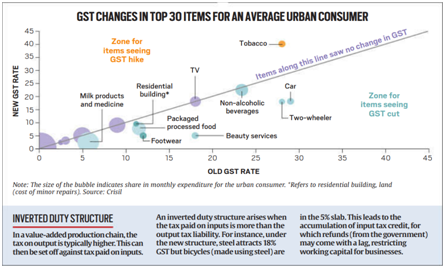
- Consumer Impact:
- Household expenditure expected to decline due to reduction in rates of essential goods like milk products, footwear, and packaged food.
- Some items such as tobacco continue to be taxed at higher rates for revenue and health concerns.
Inverted Duty Structure (IDS): A Persistent Issue
- Definition: IDS arises when input tax is higher than output tax, leading to accumulation of Input Tax Credit (ITC).
- Examples: Steel taxed at 18% but bicycles made using steel at 12%.
- Concerns: Refunds are often delayed, locking working capital for businesses, especially SMEs.
Expected Benefits
- For Consumers:
- Increased disposable income, enhancing demand for goods and services.
- Reduced litigation due to simplified classification.
- For Businesses:
- Lower compliance burden, promoting ease of doing business.
- Potential rise in investment due to predictable tax environment.
- For Government:
- Streamlined revenue inflow through reduced evasion.
- Enhanced efficiency in tax collection via harmonised slabs.
Challenges and Concerns
- Incomplete IDS Resolution: Certain sectors (fertilisers, textiles, bicycles) continue to suffer from blocked credit.
- Revenue Concerns: Excessive rate cuts could limit fiscal capacity of the government.
- Frequent Changes: Continuous modifications in slab rates may cause uncertainty for businesses.


Prelims Articles
Context:
CPCB’s latest assessment shows a slight decrease in the number of rivers unfit for bathing in 2023 compared to 2022.
India River Pollution Status
- Biological Oxygen Demand (BOD): Primary indicator used by CPCB to measure organic pollution in rivers. BOD > 3 mg/L is considered unfit for bathing.
- Polluted River Stretch (PRS): Defined as two continuous locations exceeding BOD limits in a river.
- Key Data (2023 vs 2022):
- Rivers unfit for bathing: 807 (2023) vs 815 (2022).
- PRS locations: 296 in 271 rivers (2023) vs 311 in 279 rivers (2022).
- Priority 1 (most polluted, BOD > 30 mg/L): 37 stretches (2023) vs 45 stretches (2022).
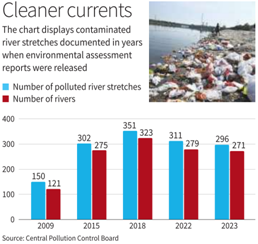
- State-wise Highlights:
- Highest PRS: Maharashtra (54), Kerala (31), MP & Manipur (18 each), Karnataka (14).
- Highest Priority 1 stretches: Tamil Nadu, UP, Uttarakhand (5 each).
- Monitoring Network: CPCB monitors 4,736 locations including rivers, lakes, canals, and drains.
- Implications for Policy: Indicates incremental improvement in river health but continued priority on pollution hotspots; essential for NamamiGange Mission, National River Conservation Plan, and Sustainable Development Goal (SDG 6 – Clean Water and Sanitation).


Prelims Articles
Context:
Researchers have demonstrated the use of optical fibres to perform AI tasks faster and more efficiently than conventional electronic computers.
Optical Computing:
- Uses photons instead of electrons to process data, enabling higher speed, bandwidth, and energy efficiency.
Nonlinear Regime of Light:
- High-intensity light pulses in optical fibres create interactions that can perform complex transformations useful for AI computations.
Extreme Learning Machine (ELM):
- A simple neural network with a single hidden layer; output weights are trained in one step. Optical fibres serve as the hidden layer by transforming input data (images) into light pulse fingerprints.
Process Overview:
- Input image downsized and encoded onto light pulses (phase/amplitude at different frequencies).
- Light pulses travel through optical fibres, exploiting nonlinear effects and dispersion.
- Resulting light spectrum (“fingerprint”) acts as the hidden layer input for ELM classification.
Performance:
- Achieved >91% accuracy in the anomalous dispersion regime and >93% in the normal dispersion regime, comparable to conventional ELMs.
Significance:
- Demonstrates potential for faster, energy-efficient AI hardware, enabling optical neural networks and photonic integrated circuits in the future.
Limitations:
- Real-world effects such as light polarization not fully utilized; future research could enhance performance.


Prelims Articles
Context:
A former banker in South Delhi lost ?23 crore to a cybercrime called ‘digital arrest’, highlighting increasing online frauds targeting citizens.
Nature of Digital Arrest Scam:
- Scammers impersonate police or telecom officials, claiming the victim’s mobile number is used for fraudulent or illegal activity.
- Threats include fake investigations, intimidation, and digital confinement via calls or video conferencing apps (Skype, WhatsApp).
Mechanism of Fraud:
- Callers often convince victims to transfer money or reveal sensitive data.
- Targets are often elderly or unsuspecting individuals.
- Payments are siphoned through multiple transactions across banks.
Preventive Measures & Technology:
- ‘Sanchar Saathi’ app by the Department of Telecom allows verification of mobile numbers and Aadhaar to check misuse.
- Reporting suspicious numbers can block the IMEI or prevent fraud.
- National Cyber Crime Reporting Portal (NCRP) and 1930 helpline help victims report cyber fraud promptly.
Regulatory & Legal Guidance:
- Indian Cyber Crime Coordination Centre (I4C) issued advisories on digital arrest scams.
- No legal provision exists for actual digital arrests, highlighting the importance of awareness and verification.
- Victims are advised to contact local police and avoid transferring money without verification.


Prelims Articles
Context:
India observes Ayurveda Day on September 23, 2025, with the theme “Ayurveda for People & Planet” to promote traditional medicine globally and integrate it into modern healthcare systems.
Ayurveda Day 2025
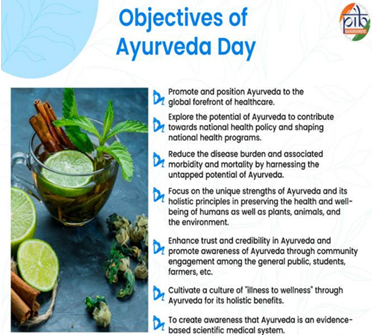
- Theme: “Ayurveda for People & Planet”
- Theme Significance: The theme emphasizes holistic health by linking human wellbeing with environmental sustainability, reflecting Ayurveda’s preventive and integrative approach.
- Global Outreach: Initiatives like World Ayurveda Congress, AYUSH Information Cells in 30+ countries, and Chairs in foreign universities promote India’s traditional medicine on the global stage.
- Government Initiatives: The Ministry of AYUSH and CCRAS launched programs including “Desh ka SwasthyaParikshan”, DRAVYA Portal, and APTA Portal to standardize, document, and propagate Ayurveda knowledge.
- Integration in Healthcare: Inclusion of Ayurveda, Siddha, and Unani in ICD-11, standardization by BIS, and international MoUs strengthen research, insurance coverage, and global credibility.
- Public Engagement: Nationwide events, health services during MahaKumbh 2025, and awards like National Dhanwantari Ayurveda Awards recognize practitioners and promote excellence.
- Economic and Soft Power Impact: The AYUSH sector, including exports and global partnerships, enhances India’s soft power while contributing to healthcare innovation and economic growth


Editorials
Context:
The Supreme Court reaffirmed secularism as a part of India’s Constitution while dismissing a petition challenging a Muslim author’s participation in the Mysuru Dasara festival.
Constitutional Principles
- Secularism as Basic Structure: The Court reiterated that secularism is a fundamental part of India’s constitutional framework.
- Equality in State Events: Public events organised by the State cannot discriminate based on religion, ensuring inclusive participation.
- Freedom of Religion Clarified: Articles 25 and 26 guarantee individual religious rights but do not restrict others from participating in cultural or religious celebrations.
Context of Mysuru Dasara
- Festival Participation: Banu Mushtaq, a Muslim author, inaugurated the festival at Chamundeshwari Temple as part of a State-sponsored cultural event.
- Legal Validation: Both the Karnataka High Court and Supreme Court upheld that her participation did not violate any constitutional provision.
- Public vs Private Events: The Dasara festival is a public event, not a private religious ceremony, allowing people of all faiths to partake.
Social and Political Implications
- Pluralistic Society: Restricting participation in public gatherings based on religion undermines India’s social harmony.
- Historical Unity: Festivals and pilgrimages have historically united diverse communities, transcending social and religious barriers.
- Political Misuse: Opportunistic political actors exploit communal sensitivities, creating rifts and threatening coexistence.
Practice Question:
Examine the role of secularism in India’s public life and discuss how judicial intervention ensures protection of constitutional principles during state-sponsored cultural events.


Editorials
Context:
The article highlights the immense responsibilities, challenges, and burnout faced by Primary Health Centre (PHC) doctors, underscoring the need for systemic reform in India’s primary healthcare system.
Roles and Responsibilities
- Clinical Care: PHC doctors provide comprehensive medical services to communities of 20,000–50,000 people, including women, children, elderly, and vulnerable groups.
- Public Health Functions: They coordinate immunisation campaigns, disease surveillance, school health programs, and vector control, linking policy to grassroots implementation.
- Community Engagement: PHC doctors mentor ASHAs, ANMs, visit Anganwadis, participate in Gram Sabhas, and ensure health programs reach the last mile.
Challenges and Workload
- High Patient Load: On busy days, PHC doctors attend up to 100 outpatients and 100 antenatal visits, managing diverse medical conditions across age groups.
- Multi-Specialty Expectations: They must remain updated in newborn care, geriatrics, infectious diseases, mental health, trauma, and chronic illnesses, delivering emergency care independently.
- Burnout Risk: The combination of clinical, administrative, and public health responsibilities causes emotional exhaustion and detachment, affecting physician well-being.
Systemic Issues and Reform Needs
- Administrative Burden: PHC doctors maintain over 100 registers and multiple digital systems like IHIP, PHR, IDSP, and HMIS, often duplicating data entry.
- Need for System Redesign: Automation, delegation of non-clinical tasks, and reduction of redundant documentation are required to reduce workload and enhance efficiency.
- Primary Care as Foundation: Strengthening PHCs is essential for achieving Universal Health Coverage (SDG 3.8) and ensuring equitable access to healthcare, making physician welfare a systemic priority.
Practice Question:
Critically examine the role of Primary Health Centre (PHC) doctors in India’s healthcare system and discuss the systemic reforms required to reduce their administrative burden and prevent burnout.


Editorials
Context:
The article highlights the growing relevance, global expansion, and scientific validation of India’s traditional medicine systems, particularly Ayurveda and the broader AYUSH sector.
Global Relevance and Market Growth
- Wide Usage: Traditional medicine is practised in 88% of WHO member states, serving billions due to affordability and accessibility.
- Market Expansion: The global traditional medicine market is projected to reach $583 billion by 2025, with China, Australia, and India being key contributors.
- Preventive Approach: Traditional medicine emphasizes proactive, preventive care addressing root causes rather than just symptoms.
India’s AYUSH Transformation
- Industrial Growth: India’s AYUSH sector, with over 92,000 MSMEs, has grown eight-fold in under a decade, with manufacturing and services revenues exceeding ?1.37 lakh crore and ?1.67 lakh crore respectively.
- Global Exports: India exports AYUSH products worth $1.54 billion to over 150 countries, enhancing soft power and international recognition of Ayurveda.
- Public Awareness: NSSO survey (2022-23) reports near-universal awareness (95–96%) and widespread usage of AYUSH, with Ayurveda being preferred for preventive and rejuvenation care.
Scientific Validation and International Outreach
- Research Investment: Institutions like All India Institute of Ayurveda and CCRAS focus on clinical validation, drug standardisation, and integrative care models combining traditional and modern practices.
- Global Partnerships: India has signed 25 bilateral agreements, 52 institutional partnerships, established 43 AYUSH Information Cells, and positioned 15 academic chairs abroad to promote traditional medicine.
- Technology Integration: WHO-supported initiatives integrate AI and digital tools into traditional medicine, enhancing clinical validation, predictive care, and big-data analytics.
Practice Question:
Discuss the growing global significance of India’s traditional medicine systems, with reference to AYUSH, and examine the role of scientific validation and international cooperation in mainstreaming traditional healthcare.



